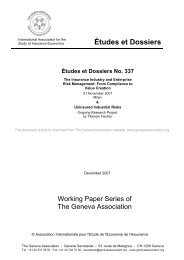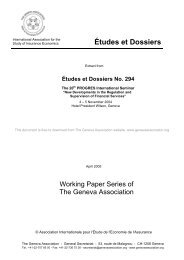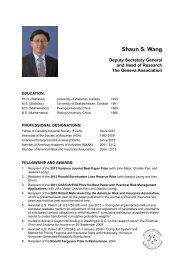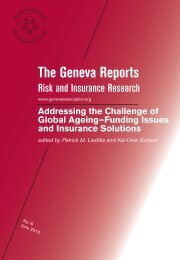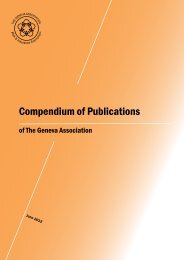Addressing the Challenge of Global Ageing—Funding Issues
Addressing the Challenge of Global Ageing—Funding Issues
Addressing the Challenge of Global Ageing—Funding Issues
You also want an ePaper? Increase the reach of your titles
YUMPU automatically turns print PDFs into web optimized ePapers that Google loves.
38<br />
<strong>Addressing</strong> <strong>the</strong> <strong>Challenge</strong> <strong>of</strong> <strong>Global</strong> Ageing—Funding <strong>Issues</strong> and Insurance Solutions<br />
in <strong>the</strong>ir old-age. Yet, due to global ageing and <strong>the</strong> shrinking <strong>of</strong> working populations, tax<br />
revenue may be insufficient to meet pension promises, leading to possible distributional<br />
crises and thus shortages in old-age income. Contributors to a pre-funded pension system<br />
also obtain a claim on future benefits but in a different way. They accumulate financial<br />
assets, mainly bonds and equity, which are later sold to younger workers. A large number<br />
<strong>of</strong> retirees who want to sell and a low demand for <strong>the</strong>se financial assets can cause asset<br />
prices to fall longer-term, lowering <strong>the</strong> market value <strong>of</strong> pension funds and also pension<br />
benefits, especially in <strong>the</strong> case <strong>of</strong> defined contribution schemes.<br />
The period <strong>of</strong> retirement leng<strong>the</strong>ned considerably during <strong>the</strong> 20th century, especially<br />
after 1960 when <strong>the</strong> average worker who retired could expect to have 10 or so years<br />
<strong>of</strong> retirement. Nowadays, this period has extended to 20 years or more (see Figure 2).<br />
Hence, not only individuals face <strong>the</strong> risk <strong>of</strong> having a reduced old-age income, but <strong>the</strong>y<br />
also run <strong>the</strong> risk <strong>of</strong> being exposed to higher expenses since retirement periods are longer.<br />
This means that <strong>the</strong>y should save even more for <strong>the</strong>ir retirement. However, many people<br />
fail to do so. They may lack <strong>the</strong> financial literacy necessary to plan ahead properly<br />
and <strong>the</strong> awareness <strong>of</strong> <strong>the</strong>ir future needs. They may also underestimate <strong>the</strong> amount <strong>the</strong>y<br />
need to retire safely, <strong>of</strong>ten by underestimating <strong>the</strong>ir future longevity. They also have<br />
limited financial resources and are prone to myopic behaviour, thus prioritising current<br />
consumption over saving for future needs.<br />
Figure 2: Average life expectancy after pensionable age in <strong>the</strong> OECD, 1960-2050<br />
26.5<br />
24.5<br />
22.5<br />
20.5<br />
18.5<br />
16.5<br />
14.5<br />
12.5<br />
1958 1971 1983 1989 1993 1999 2002 2010 2020 2030 2040<br />
Source: OECD (2011a).<br />
In addition, rising health care costs influence old-age income. Health spending is more<br />
and more correlated with age. As mentioned earlier, older people in general are reporting<br />
a greater number <strong>of</strong> chronic conditions and disability. Per capita health care costs <strong>of</strong> <strong>the</strong><br />
retired are considerably higher than for <strong>the</strong> working age population (see OECD, 2011b).<br />
However <strong>the</strong>re is a difference between increasing expenditure (which relates to <strong>the</strong> real<br />
increase <strong>of</strong> value added) and cost inflation. It is important to distinguish clearly between<br />
<strong>the</strong> two different mechanisms. One is health cost inflation, i.e. when <strong>the</strong> same treatment<br />
Men<br />
Women



